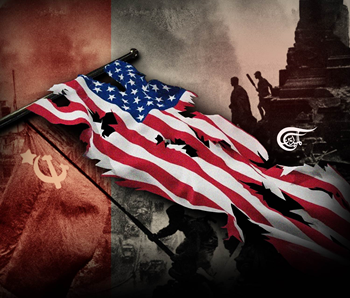The reality the US is stuck with is that its global system of economic, political and military control is ever more precipitously disintegrating.
The Soviet collapse signaled the end of not just Marxism-Leninism as a political force, but western Liberalism itself.
In historical terms, the twentieth century could be said to have been relatively short in that its defining events happened closer to each other in time, certainly in comparison to the ‘long’ 16th and 19th centuries. 1914 is typically taken to be the beginning of this period, given the outbreak of the First World War, setting in motion everything that was to follow, the carnage of the trenches, the Russian Revolution of 1917, the Great Depression and the Second World War, the second act of what began in 1914.
Europe emerged from 1945 in ruins and no longer dictating the world’s destiny for the first time in five centuries. In its place, the globe was divided between two supposedly ‘anti-colonial’ powers, the USA and USSR, championing their own versions of national self-determination and economic ‘modernization’ within the context of a worldwide ideological struggle between their respective national religions.
For the American-led west, this religion was Liberalism, a political response to the democratic movements of the 19th century that declared the “ignorant herd », in other words the majority of the populace, to be unqualified and unsafe decision makers for society. Direct participation in the national political life was to be limited to a privileged clique of qualified technocrats; the social scientists, the journalistic class, and captains of industry and their lobbyists serving as the titular heads of the approved political parties.
In opposition to this ideology, we are told, was Marxism-Leninism as promulgated by the leadership of the Soviet Union where power was held by a ‘revolutionary vanguard’ of the Communist Party leadership. The great mass of society, it was concluded, had to be led by force, through what were thought to be the inevitable stages of economic development culminating in socialism on the ever-receding horizon. One of the many perversities of the twentieth century was the creation of much the same exploitation of labor and environmental destruction under the pretext of eventually transcending it.
Beneath the rhetorical differences, the two ideologies were more alike than different in the ways they functioned in the real world and especially in the assumptions they had about how much of society was qualified to have a political voice. The late American sociologist Immanuel Wallerstein, in his post-mortem of the USSR in ‘After Liberalism’ went so far as to claim that they were one and the same ideology. Going still further, he asserted that in the Cold War, the USSR acted as a de-facto American proxy in the way that it steered potentially dangerous third world nationalisms into a more politically attractive variant of western Liberalism, maintaining their country’s place in the existing world system.
Where mass-movements escaped the control of either superpower as in Civil-war era Spain, the Maoist seizure of power in China or the Islamic Revolution in Iran, the superpowers invariably found themselves both trying to sustain the forces of the status-quo.
Of course, we well know that this highly constrained system of governing the world did not last. The Cold War, and by extension the historical twentieth century, came to an abrupt end in 1989. In a state of internal disintegration, the USSR withdrew in humiliation from the quagmire of Afghanistan and then from its own designated sphere of influence in Eastern Europe, allowing its satellites in East Germany, Poland, Romania, and others to be overthrown. Such was its state of collapse that it did not survive long enough to be digested by Western capital. The Union, stripped of its empire, disintegrated in the second half of 1991, its last leader Mikhail Gorbachev resigning in disgrace and declaring the Soviet Union dissolved on Christmas Day.
Exactly 30 years have now passed since the death of the only power ever credibly presented as a challenger to the United States and 33 years since the end of the post-World War II global order and the twentieth century as a whole. Still all these years later, these momentous events, unforeseen by the Western security and military establishments, are still paraded as the final triumph of the western capitalist system and the dawn of a new unipolar American century.
With the benefits of hindsight, it is understandable that people would have interpreted events in that way. Since the onset of near permanent economic crisis in 2008, the deeply divisive Brexit referendum and the election of Donald Trump in the US in 2016, Wallerstein’s prognoses seem ever more eerily prescient. Rather than being the defeat of an alternative to western Liberalism, the fall of Marxism-Leninism as a viable political system signalled the beginning of the end of the West’s ideological hegemony. Into the ideological vacuum of the former Soviet Union has flowed all manner of radical, democratic, neofascist, indigenist, and nationalist political movements. From the Zapatista uprising against NAFTA in 1994, to the birth of the nascent pan-Islamic, pan-Arabist Ansar Allah Movement in Northern Yemen the same year to the return of narrow European nationalisms, the rising anti-systemic movements are far less co-optable by the global North since they generally reject the basic assumptions of Liberalism that have gone unchallenged for some two centuries.
The American-led west has spent the last 30 years scrambling to find a substitute for the ‘communist menace’ with which it justified its global military, economic, and cultural footprint. From 2001 up to around the election of Donald Trump the chosen enemy was « Islamist terrorism », a conveniently vacuous category that swept up all religiously oriented Arab and Islamic popular movements of which Washington disapproved. Since 2016, the United States seems to have been pivoting to its old red-baiting tactics surrounding non-existent or inconsequential Russian and Chinese ‘interference’ in western elections. The Biden administration may well believe that US hegemony will rest more securely on a Cold War 2.0 and a theatrical power-struggle with China and Russia. The world, however, has not and will not return to the world of pre-1989. Russia is a shadow of its Soviet incarnation and a strategic threat to the west insofar as it continues to be cornered by NATO. Meanwhile, China remains deeply enmeshed within the global capitalist system which the US principally constructed.
Finally, the degree of internal division and unrest in the US itself negates the possibility of returning to the old Liberal consensus, however much Biden may fancy himself another FDR or LBJ. With a previously unthinkable number of Americans questioning the legitimacy of their own elections, the inexorable centrifugal forces that tore the communist world apart and are now clawing at the EU have finally reached the heart of the global capitalist system itself.
If the United States could wish about its ideal century, it would be a renewed Cold War against Moscow and Beijing. The reality it is stuck with is that its global system of economic, political and military control is ever more precipitously disintegrating.
The opinions mentioned in this article do not necessarily reflect the opinion of Al mayadeen, but rather express the opinion of its writer exclusively.





